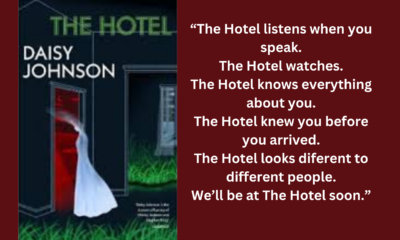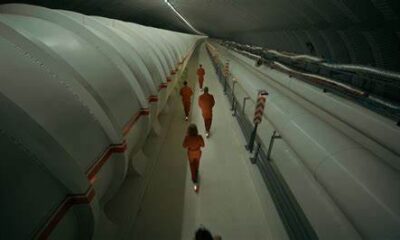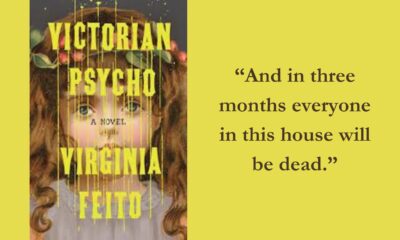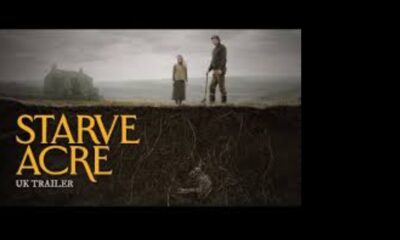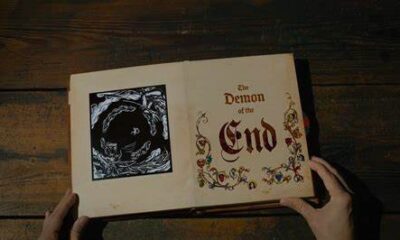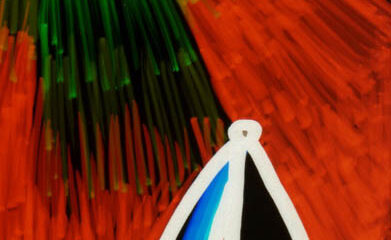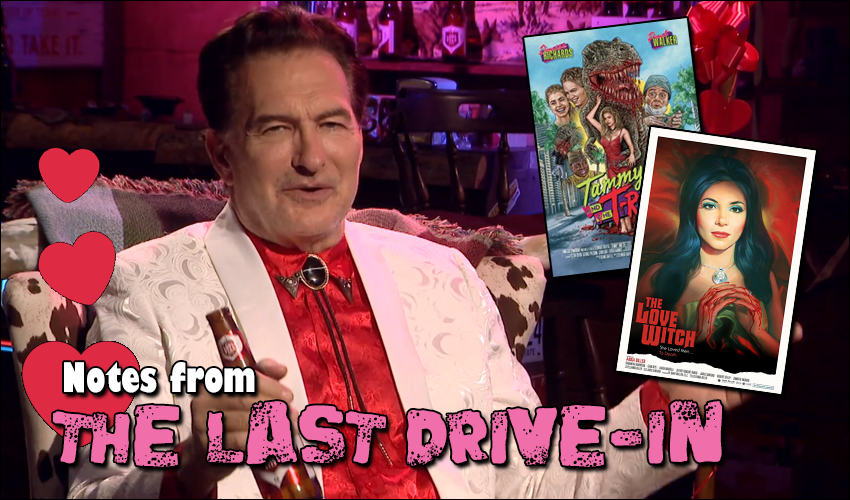
Notes from The Last Drive-In: Joe Bob Put a Spell on You
More Videos
Published
4 years agoon
Joe Bob Briggs and Shudder deliver a Valentine to the MutantFam with the release of a Valentine’s Day special, “Joe Bob Put a Spell on You.” It was a night of love, sex, magic, and dinosaurs and the sort of shocking wedding you’d expect from the trashiest of soap operas. Plus, all the sheer, unadulterated Yuki lust was just too hot to handle.
It’s the sticky, oozy love that you need to take a shower to get off of you in this special. Our two films? 1994’s Tammy and the T-Rex and the recent, retro-throwback The Love Witch.
Let me whisper some sweet nothings into your ear about it…
Wackiest funeral since Heathers.#thelastdrivein @therealjoebob @kinky_horror @shudder
— Haunted MTL 🏳️🌈 (@HauntedMTL) February 13, 2021
Tammy and the T-Rex (1994)
Unethical Science Fu#thelastdrivein @therealjoebob @kinky_horror @shudder
— Haunted MTL 🏳️🌈 (@HauntedMTL) February 13, 2021
Opening: Wild Man Weekends
Haunted MTL is no stranger to the unique joys of 1994’s Tammy and the T-Rex. This cult classic pretty much tells you everything to expect from the movie in style and substance from it’s IMDB synopsis:
An evil scientist implants the brain of Michael, a murdered high school student, into a Tyrannosaurus. He escapes, wreaks vengeance on his high school tormentors, and is reunited with his sweetheart Tammy.
If that does not scream B-movie fun and drive-in fodder I worry about how you define those things.
So, Tammy and the T-Rex is the stuff of legend, or at least as legendary as 1994 dinosaur high school films can be. The film, directed by Stuart Raffill, was written by Raffill with Gary Brockette, and had its script turned around in about a week subject to the revelation that Raffill had access to an animatronic T-Rex. The film stars relative newbies Denise Richards and the titular Tammy, Paul Walker as the hunky-boyfriend-cum-robot-dinosaur, and the film is basically stolen by Theo Forsett as Byron. Oh, and the biggest star is, of course, the life-sized animatronic Tyrannosaurus Rex. I could also go on about all the other great character actors in the film, a hallmark of any great drive-in movie. The movie has a solid cast of characters of all stars, stripes, and claws.
The film is the good kind of cheap. Not at expense of the overall quality, but because of the ingenuity involved in production because most of the money went toward a T-Rex that had to spend a lot of time stationary, barring shots involving a moving head. The film is also a great example of the sort of controlled-chaos of the best drive-in movies. A pivotal scene of Tammy riding Walkersaurus-Rex off into the distance was short amidst a photogenic orange sky, but the orange was due to wildfires raging at the time. Sometimes smoke from the fires even show up in frame. How could the film even be filmed in such conditions? A $250 bribe to the right people.
It’s just that sort of movie.
The writing will not generally “wow” most people. There are jokes that simply don’t really land today, and probably never really did. The plot is insane and a lot of logic flies out the window when you deal with brain transplants into robot dinosaur bodies. The film also rewards the actors who are best able to commit to the absurdity of it all, with Paul Walker and Denise Richards proving surprisingly adept at walking the line between sincere and silly. Theo Forsett, playing Tammy’s gay bestie, however, absolutely steals the show. But everyone from the mad science party to the police to the dopey-ass teens deliver some fun, campy performances.
The film, originally released as a PG-13 family film, which makes absolutely no sense, is in many ways saved by it’s “gore cut” which is what The Last Drive-In opted to show. The camp of the film is elevated to incredible levels and the gore is absolutely hilarious, and arguably necessary to the film.
A lot of Joe Bob’s factoids of the film sort of worked their way into my review, which happens when so much great information is given. Among the highlights is the reveal that we were absolutely robbed of more Theo Forsett, who made Tammy and the T-Rex his final film. He is probably happily retired somewhere. The other strange reveal, Stuart Raffell would work again with J. Jay Saunders (sheriff and Byron’s father) for the film Lost in Africa (1994). The curiosity here? It was financed by the Duke of Northumberland to promote wildlife conservation.
Huh.
The principal gag of the night, dealing with the topics of love and witchcraft, were shenanigans involving potions. Throughout the night love, or something like it, was sought through the creation of potions, all revolving around witchcraft, as befits the second movie of the night. As far as the setting, we are still in the cabin in New Jersey, a lingering reminder of the coronavirus on production. The cabin is starting to grow on me, however. The last Halloween special was a bit rough and felt a bit isolated in a way that stripped the fun out of the experience, but things are becoming a little more homey with each new special set in the cabin.
That being said, I really want to get back to the trailer. It’s an iconic set design.
For a Valentine’s Day special, Tammy and the T-Rex is a surprisingly perfect choice that illustrates undying love that comes in surprising forms, and that the right person will move Heaven and Earth to be there for you. It also features a robot-dinosaur that murders several people in cartoonish gory ways. Joe Bob Briggs gave the film four stars, which I’d say is a fair assessment and well deserved. It is impossible to find something to dislike in this movie, for me. On that note, I give Tammy and the T-Rex the five Cthulhu treatment.
 (5 / 5)
(5 / 5)
Best Line: “He’s a brother. Soulfood. Rythym.” – Byron handling a corpse for a potential brain transplant.
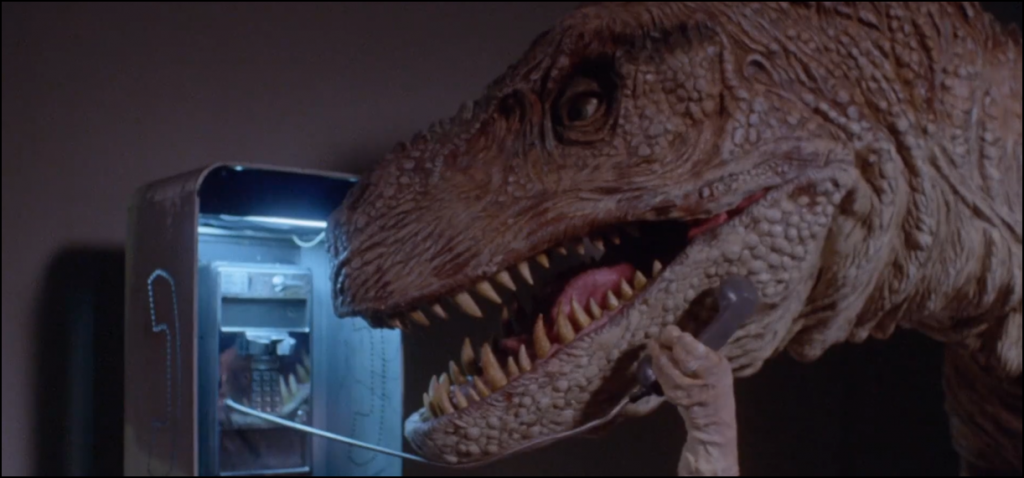
The Love Witch (2016)
"Witch bottle?"
— Haunted MTL 🏳️🌈 (@HauntedMTL) February 13, 2021
"The one in my hand, Officer."#thelastdrivein @therealjoebob @kinky_horror @shudder
Opening: Word choice matters, an etymology lesson.
I came into the Valentine’s Day special already very, very excited because I had guessed that 2016’s The Love Witch was going to be one of the films for the night. It is in many ways the perfect film for The Last Drive-In‘s approach to Valentine’s Day. The Love Witch is a horror comedy written, directed, edited, scored, and produced by all-around badass Anna Biller. It is an absolutely gorgeous 1960s-throwback in visuals but with modern feminist themes and explorations into contemporary gender roles, sex, and love.
The IMDB synopsis doesn’t give away the story, but doesn’t exactly really sell just how good the film is.
A modern-day witch uses spells and magic to get men to fall in love with her, with deadly consequences.
The movie was a limited release but caught the attention of horror fans, witchcraft enthusiasts, and cinephiles around the US. It had quite the impact as far as cult projects go. Anna Biller gathered a talented group of naturalistic actors, including Samantha Robinson as the titular Love Witch, Gian Keys as the detective who she falls for, and Laura Waddell as the real-estate agent whose life Elaine selfishly ruins. My only real criticism of the film, a minor one, is that the performances could have been a touch more camp. Not overwhelmingly so, of course. I understand Biller’s choices when it comes to how she wanted scenes played… but I do want to see the more tongue-in-cheek version of The Love Witch.
There is a lot going on with this movie, and a lot to say, more so than I can do in this article. As far as why the film is so good, though, there are a couple of reasons: the style, the exploration of gender, and the usage of witchcraft.
Stylistically, this movie is astounding, taking some of the aesthetics of the 1960s and transplanting them to the modern-day. The effect is so good, that moments where cell-phones and modern cars pop up feel positively anachronistic because you’ve been so pulled into the technicolor stylings of the camera and design. So much of that is at the hand of Anna Biller who led virtually every choice seen on-screen, down to costumes and set design, collecting and crafting items for the film herself. The colors, as well, stand out. The film uses the technicolor aesthetic well, with bright colors emphasizing moods, traits, and on-screen magic. At times you wonder if you’ve maybe watched a lost Alfred Hitchcock film, or perhaps something from Hammer Horror.
The other two reasons for the film’s success, the exploration of gender and the film’s usage of witchcraft is also of note and deserve to be explored in a much more thorough essay. At heart, though, during her discussion with Joe Bob Briggs, Anna Biller mentions the female gaze and how that gaze is reflected in the witchcraft done in the film, which I think makes up the heart of the movie. The movie is all about the selfish desires of the narcissistic Elaine and the tragedy that transpires all derives from her inability to come to terms with her desires and how she wishes to see love written in the way she mistakenly believes it must be for her to be fulfilled. The problem is that Elaine can never be fulfilled and magic becomes a sort of addiction to fill that missing something in her life.
As far as the episodic festivities with Joe Bob, Darcy, Yuki, and the behind-the-scenes crew, we still have everyone held hostage at the cabin with Joe Bob doing the best he can. Darcy has also grown to be a snarkier and more assertive presence in the show, which I welcome entirely. I’ve followed JBB for a long time, since I was a kid, really, and Darcy is the most-involved and most fun Mail Girl of the bunch.
As for the potion shenanigans, all the strange brews begin to have some delirious and fun effects on the show, with Joe Bob and Darcy both feeling a little something about the resident Kyoto Cowboy, Yuki, and culminates in trippin’ Joe Bob hallucinating (or was he?) a Ren-Faire wedding between Darcy and a cardboard cutout of Tom Atkins. It’s one of the most deliriously funny, and out-there skits in the show, and I was reminded of the host segments from Mystery Science Theater 3000.
The real highlight of the host segments, however, was the interview with Anna Biller. Socially distanced through a screen on the body of a mannequin, the interview proved to be a fascinating discussion and love letter to film in general, perhaps the real Valentine of the night. Joe Bob’s understanding of film is that of a master, but even the master himself can learn something new, and Anna Biller brings in some great moments with our host. Of note was her discussion of the female gaze. There is a moment where you see something on Joe Bob Briggs’ face… a genuine moment of surprise and delight – all in raised eyebrows and wide eyes.
This was perhaps my favorite guest spot on the show. I love getting actors and such on the set, do not get me wrong, but something about the behind-the-scenes directorial talent just adds something special to The Last Drive-In. Anna Biller might be the best guest since ol’ Uncle Lloydie. I was absolutely thrilled to just hear Briggs and Biller talk, and I think Shudder is sitting on a potential podcast of Joe Bob talking horror with the people who make it. It feels appropriate to their brand, gives Joe Bob more money, and makes the fans happy. I hope it happens one day.
I have to quibble with Job Bob giving The Love Witch the mere three-and-a-half stars he opted for. Generally, I feel his judgment is pretty strong, but there really is no reason not to give The Love Witch perfect marks. Hell, it has 25 breasts, blood, and it has the beast with two backs. It’s a triple-B feature with the aesthetic and indie credit of “real” film. As far as I could tell, he didn’t really deliver much in the way of a major critique of the film either, leaving me a bit lost in his reasoning. As for me, The Love Witch is a perfect film, and it’s pretty hot too, in a number of ways. See it with your partner while having a glass of wine. Trust me. I give it the full five Cthulhu treatment.
 (5 / 5)
(5 / 5)
Best Line: “I’m the love witch! I’m your ultimate fantasy!” – Elaine, not being wrong…
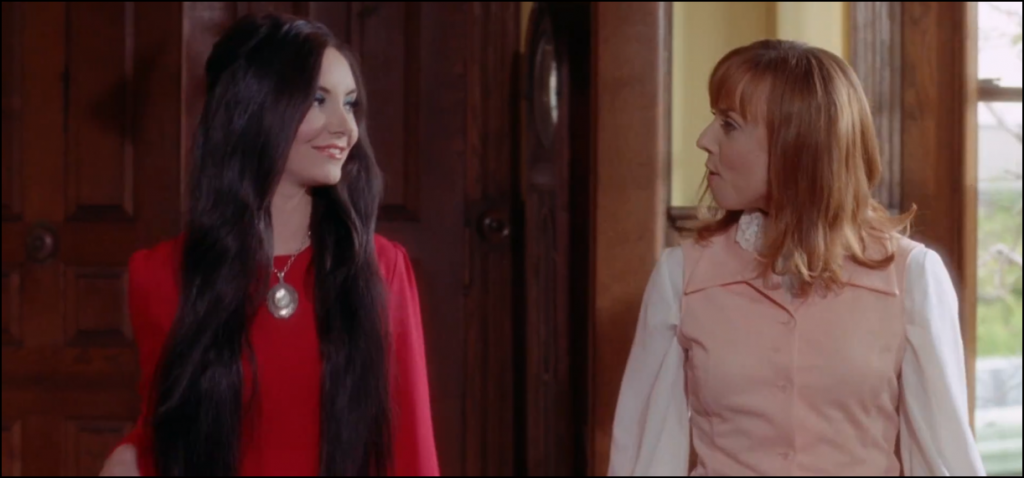
Haunted MTL Drive-In Totals
We start, of course, with the official totals. Thanks, Shudder.
Four well-earned stars for the Rex with the flex! 🦖❤️👩 #TheLastDriveIn pic.twitter.com/rDL6gd8xUi
— Shudder (@Shudder) February 13, 2021
Your drive-in totals for The Love Witch! #TheLastDriveIn pic.twitter.com/POXwvDQeFQ
— Shudder (@Shudder) February 13, 2021
As for our own quirky count, we have:
- 1 Darcy Jailing
- 2 JBB “Thee-ate-ers”
- 2 Weeks to Film Tammy and the T-Rex
- 3 Punches to Paul Walker by Strong Germanic Woman
- 3 Love Potions
- 4 Punished Testicles
- 6 Day Script
- 7 Yuki Sightings
- 7 Years to make The Love Witch
- 35mm Film
- $250 Bribe
- Gratuitous 90s Fashion
- Gratuitous “Tootsie-Wootise”
- Gratuitous Pillow Sulking
- Surprise Bard Brennan
- Braingasms
- Tamponade
- Graverobbings
- Goon Flattening
- Dinosaur Towing
- Awkward Stripteasing
- LA Joking
- Brooms in Love Joking
- Wig Fu
- Surprise Wedding Fu
- Nude Ritual Fu
- Silver Bolo Award goes to The Real Queen of Horror
- Darcy Cosplay: 3, an inflatable T-Rex suit, the striptease outfit, and the Ren-Faire wedding dress
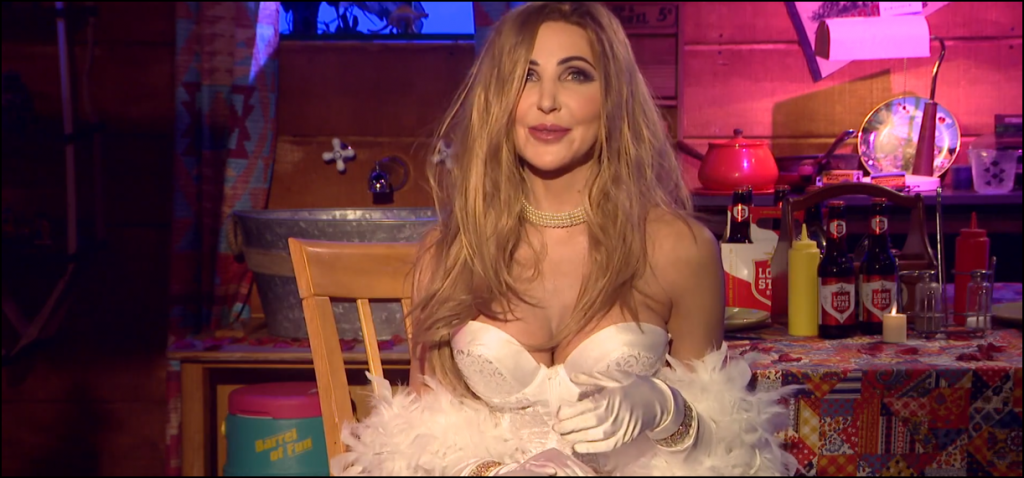
Episode Score
Over 2000 words so far on this special so far. I had a lot to say on it because it was that good, frankly. It is always a treat to discover that my favorite episode or film pairing can always update and I applaud The Last Drive-In for delivering new surprises. I do worry we may be running out of holidays, however. Maybe they can do some of the Leprechaun films for St. Patrick’s Day. Shudder can get the rights to those, right?
Maybe they can do something for Arbor Day. There is a killer tree movie out there, right?
 (5 / 5)
(5 / 5)
And, with that, we reach the end. Please let us know what you think about these recaps, and please consider commenting and sharing them to spread the word. I am not so secretly gunning for a Silver Bolo for myself one day. Why not help us out, huh?
We’ll see you at the next special or season, whichever comes first.
Hogzilla will never die.#thelastdrivein @therealjoebob @kinky_horror
— Haunted MTL 🏳️🌈 (@HauntedMTL) February 13, 2021
David Davis is a writer, cartoonist, and educator in Southern California with an M.A. in literature and writing studies.

You may like
Doctor Who
Identical: Yes. The Same: No – Exploring the World of AI Reconstructions in Doctor Who
Published
2 weeks agoon
March 19, 2025By
J M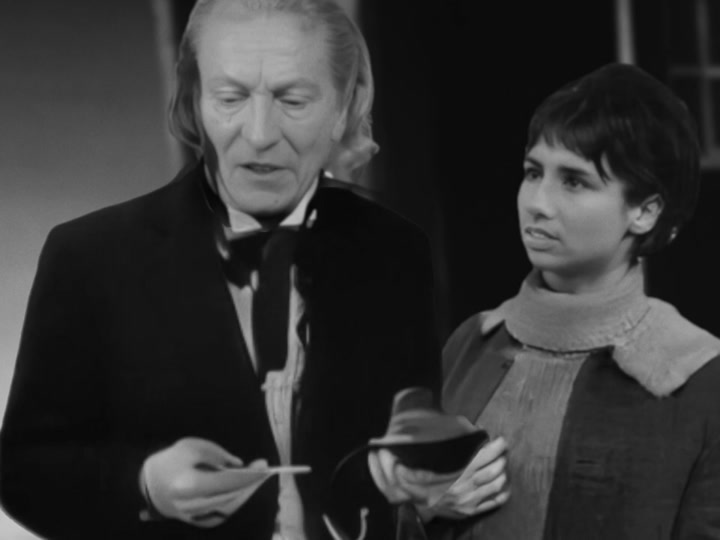
The second half of 2024 was a bit of slow for Doctor Who news. Ncuti Gatwa’s first season finished in June, and the Christmas special was months away. Comics and audio plays continued, and a Blu-Ray set of Season 25 was released – but that was all.
However, what was new and exciting was a spate of unofficial recreations of missing Doctor Who stories from the sixties. Re-animations of missing stories have occurred previously, both officially by the BBC and unofficially by fans. However, animation production time means it’s rare to have more than a few episodes a year. However within the space of six months, forty-four recreated episodes were released, with the promise of more to come.
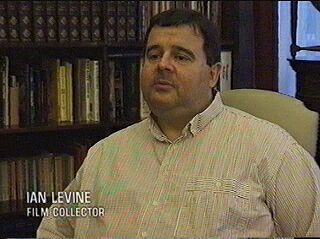
The reason how so many stories have been released so quickly is artificial intelligence (AI). These reconstructions are Generative AI, funded by professional songwriter, film producer, and fan, Ian Levine. This decision to make Doctor Who AI Reconstructions, to put it mildly, has been controversial online.
But is it worth it, in order to having otherwise missing stories returned to us? I’ve examined many of these Doctor Who AI reconstructions, and the discourse around them, to find out.
In Brief – Missing Episodes
A decent proportion of Doctor Who’s earliest years shockingly does not exist anymore. Doctor Who is one of the BBC’s biggest revenue raisers, and most famous show around the world. However it was not always the case.
When Doctor Who first began in 1963, the idea of keeping media was not really considered. Home video did not exist, and would not exist for two decades. Repeats were rare, due to the costs at the time to store old material and pay people involved in them. Also, old film presented a fire hazard. So it was often disposed of.
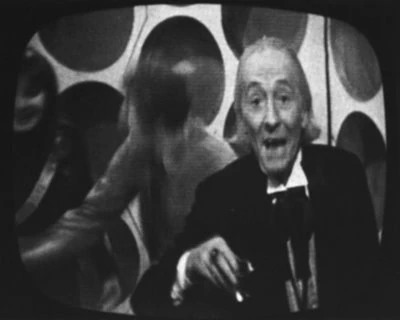
Despite this, Doctor Who is fairly lucky compared to other series. Firstly, fans at the time recorded the audio of each story. This means even the first ever Christmas Special – “A Feast of Stephen,” never broadcast internationally or repeated, still exists as an audio.
Doctor Who is also lucky because of only six seasons are not complete. In addition, of those six seasons, only half are missing only episodes from one or two stories. This allows us to get a feel for the early years of Doctor Who in a way fans of other series, like “Quatermass” and “The Avengers” aren’t able to. And part of the reason most of these early seasons survive is due to Ian Levine.
Who is Ian Levine?

Ian Levine professionally is a songwriter and DJ. He has written and produced records connected to such bands as Take That, Pet Shop Boys, Bananarama and Bucks Fizz. His total sales exceed 40 million records.
He is also well known as a prominent Doctor Who fan. There are many prominent Doctor Who fans. The series from 2004 onwards has been largely made by prominent Doctor Who fans of the 70’s and 80’s. Many of these fans contribute to Doctor Who in official ways. For instance, many older fans have written books, or audio plays. All three showrunners for the modern series would be considered prominent fans from the nineties. For Ian Levine, his main contribution is seeking to find and restore missing episodes of Doctor Who.
This work started in 1978 where Levine reportedly requested the permanent halting of old episodes of Doctor Who. At the time the idea of home video was being considered, leading to more reasons to keep old film. Levine also claimed to have rescued the first ever Dalek story from being sent into a furnace. Following this, he began purchasing private copies of the remaining stories, and attempting to return them to the BBC.
He also connected with the Doctor Who Production Team of the eighties in other ways. This included composing the theme tune for the spin-off series “K-9 and Company”, and the protest/charity album “Doctor In Distress.” His was also consulted about continuity during seasons eighteen to twenty-two.
However, he also gained a notorious reputation as obsessive in an unappealing way. During the 1985 Doctor Who hiatus, Levine was encouraged by Producer Jon Nathan-Turner to use protest the decision. Levine argued against the decision on television, and smashed his television with a hammer, and inviting newspapers to photograph it.
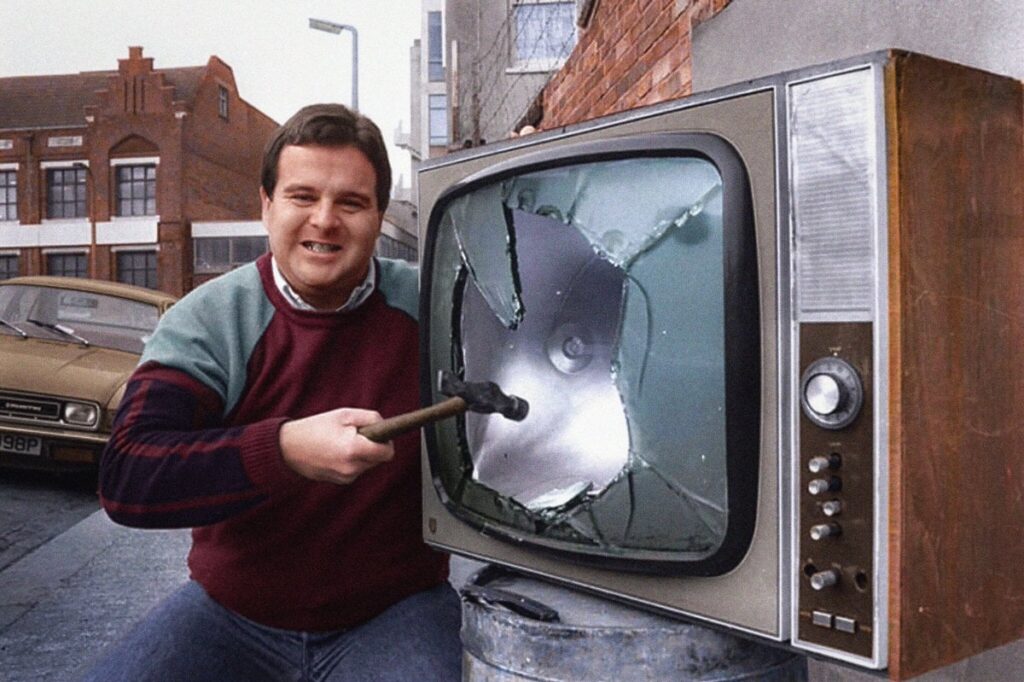
So he is fan who has both done great things, but also sought notoriety and negative attention.

More recently, Levene has worked with animating missing or incomplete episodes. This started in 2010 with “Mission to the Unknown.” This was not allowed to be shared or sold due to it being made without BBC authorization. In 2013, Ian hired an animated reconstruction of the unfinished story “Shada.” This version used pre-existing footage and new audio to create a finished product he hoped could be licensed. However, the BBC chose not to. Instead they made their own animated version that was released four years later.
- Join the Doctor (Tom Baker), Romana (Lalla Ward), and K-9 (voiced by David Brierley) as a visit to a Time Lord living incognito on Earth leads to a desperate race to a distant prison planet
- A BBC strike halted filming of this never-broadcast Baker six-episode serial written by “The Hitchhiker’s Guide to the Galaxy” author Douglas Adams
- Christopher Neame, Victoria Burgoyne co-star
Last update on 2025-03-16 / Affiliate links / Images from Amazon Product Advertising API
Subsequently, Levine made comments regarding Jodie Whittaker as the first female Doctor which were deemed by many to be sexist. Levine responded by publicly quitting the fandom, though later created his own private Doctor Who Facebook group.
This group has now become the location where his AI recreations he has funded and received donations for are shared.
The Doctor Who AI Reconstructions – How to Access
The Facebook Page: “Ian Levine’s Facebook Group” requires an agreement to two questions to join. Firstly, you must agree to respect the right to criticize Jodie Whittaker. Secondly, you must recognise this is Ian Levine’s group for sharing his opinions on Doctor Who. Agree to all this, and you’re allowed in.
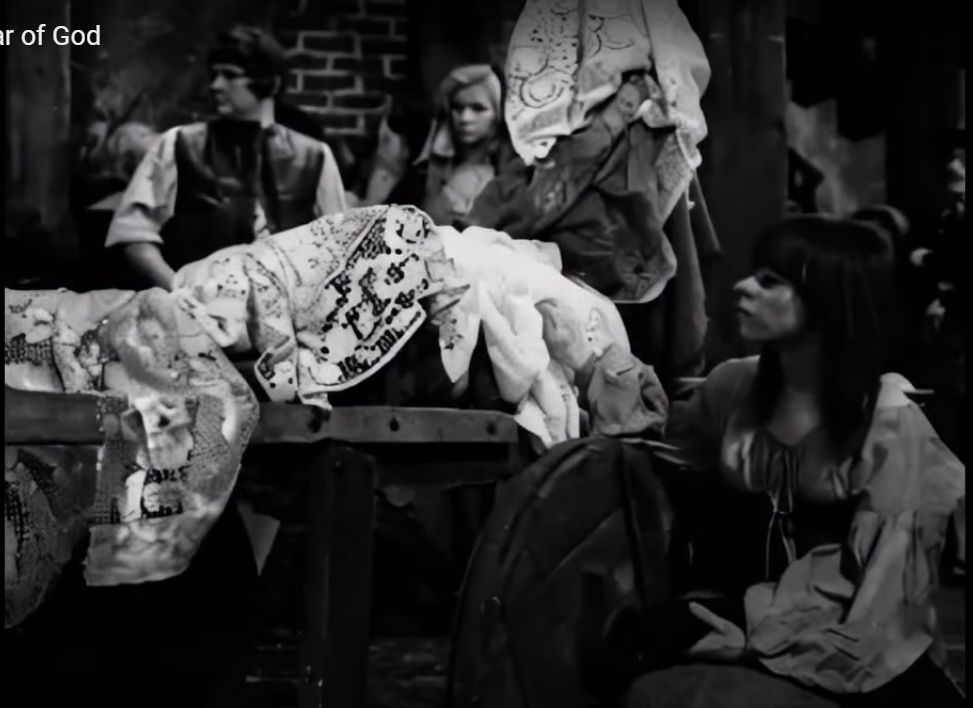
Inside the group, Levine has shared around twenty videos. This includesall of “The Dalek Masterplan,” “The Massacre,” and “The Savages.” However for the remainder, you must make a donation of fifty pounds, to become a contributor to the series.
Once your donation is confirmed, you are authorized to join the separate contributors group, for contributors only. This is where all the current videos being made are released.
Except…. None of these videos are unavailable privately. Ian Levine has placed them all on Youtube. They are unlisted, so they cannot turn up in either a Google or YouTube search. However, if you have a direct link or URL to them, they are accessible to everyone. Unlike other systems like Patreon which restrict content to only certain subscribers, nothing stops these links being shared elsewhere.
And of course, these links are shared. In response, Levine has issued threats and warnings against other Facebook groups and leakers trying to destroy his vision. In his group, people support him and join in denouncing those who criticize his work or mock it. People outside the group in response denounce Ian Levine and his supporters.
One thing I hate about internet culture is the push for tribalism. This is the idea we are joined in a selective tribe and must fight the rivals to connect. Over time the views become more strict in supporting your own tribe, and rejecting the opposition, and the middle ground is lost.
In the case of Ian Levine’s group, this is best shown by the view of alternative animations of missing Doctor Who stories. All of these are seen as not as good as Levine’s AI reconstructions. Levine’s reconstructions are seen as the only correct way Doctor Who is meant to be.
Initially Ian Levine’s AI project aimed to complete the ten missing stories not completed by the BBC. The initial project recognised the slow time it took to animate missing stories, and focused on stories that were difficult and costly to animate with people. Very soon after, however, Levine denounced many of the prior animations as “Silly Scooby Doo Cartoons.” The project was quickly extended to include stories previously animated by the BBC. Levine’s argument appears to be Levine’s objections to story changes animation had included. These included adding a surprise image of the Master in “Fury from the Deep”, prior to his debut appearance. Given Levine’s history of making things for the BBC, with the hope the BBC would license them, there have been rumours Levine initially was hoping the BBC would license some of his AI recreations, which has not come to pass.
Levine presents his animations as the most authentic way to view the missing episodes. Therefore appreciation of official animated reconstructions are not allowed. A poster saying they enjoyed the animated version of “The Celestial Toymaker,” was informed by Levine tht anyone who enjoyed the animation was unwelcome. Common responses of new animations being announced are people accusing the BBC of ruining another story. When Levine had a fault pointed out in one of his stories by Frazer Hines, who played the second Doctor’s companion, Jamie, Levine’s first response was to accept that the animation had limitations, but insisted it was still better than any animation the BBC has made. Most of all, posters all reinforce the message that AI reconstructions are the true version of the lost stories and the BBC are fools for not paying for them.
- The Celestial Toymaker sees the Doctor and his companions separated when they come up against the Toymaker
- While the Doctor plays the Trilogic Game, Steven and Dodo are forced to play their own seemingly childish, but ultimately dangerous games, with the aim of being reunited and getting back to the TARDIS
- Who will be the first to make a false move in this battle of wits, and will the TARDIS ever escape the Toymaker’s snare Fans of Doctor Who have long lamented the loss of the original 1966 master recordings of all except one of The Celestial Toymaker
Last update on 2025-03-16 / Affiliate links / Images from Amazon Product Advertising API
In response to this, or provoking this, depending on your point of you, external Facebook groups and YouTube channels are highly critical of the AI reconstructions. Some videos see them as threats, preventing the BBC from every investing in animation involving real people. Some hav dismissed the project as a scam.
So with such strong opinions on both sides, it’s time to actually watch them.
The AI Reconstructions
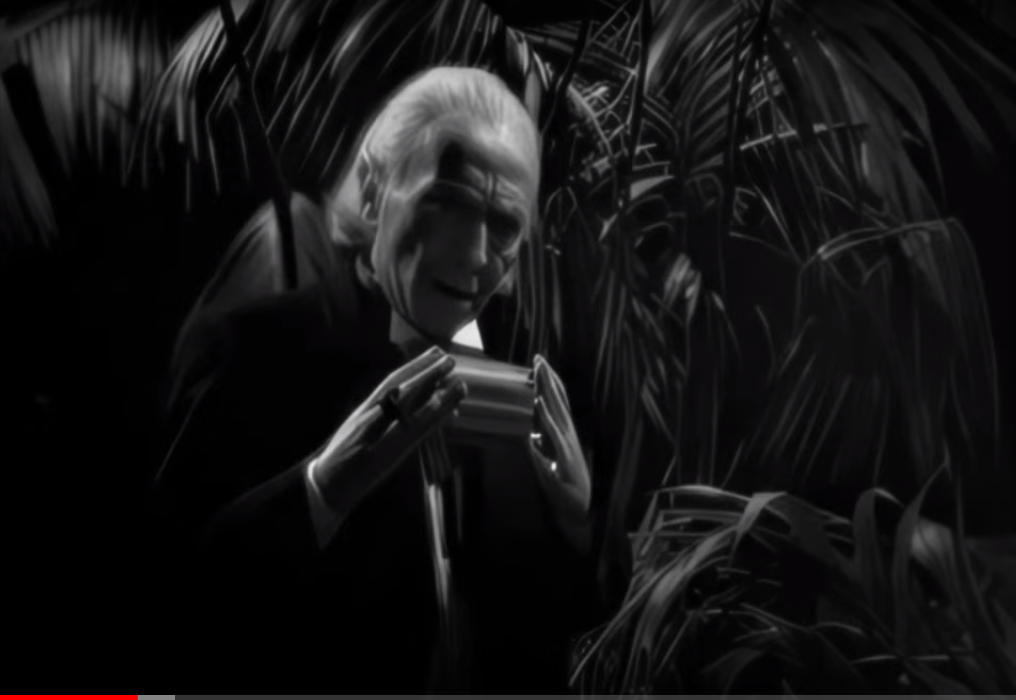
My first response on watching is they’re not that bad, but they’re not that good. Animation varies wildly in quality from story to story, making it hard to tell an overall trend towards or away from quality. However there are some good examples of how to recreate a story. “The Massacre” and “The Dalek Masterplan” for instance are incredible to watch. “The Savages” on the other hand is laughingly bad.
I chose to mostly focus on the stories not yet officially animated, so as to judge these stories by their own merit rather than compare to other animated versions of the same stories. However, it’s interesting the similarities that occur between the official animations and AI reconstructions. Non human characters (Particularly Daleks) look and move great, but people largely do not.
Animating People
Across most forms of Missing episode recovery, whether AI or human drawn, the difficulty is always animating people to show emotions and movement. Many of the official BBC animations often leave characters looking like stick figures bobbing up and down.
However one of the key things the official reconstructions provide is consistency. A human being develops a pre-existing model for characters, and because of this, these characters stay consistent over time.
AI on the other hand appears to forget things, or lose focus unless properly guided. People’s faces can change dramatically from shot to shot to the point, as in “The Savages” characters can be unrecognizable. This means, unlike with official animations, I often had to follow a story summary to figure out what was going on.
AI also forgets smaller things that make people seem human. In “The Highlanders” for instance the Doctor’s companion Polly does not blink for most of episode one, despite being in shot. This is a small detail, but throws the story into the uncanny valley – characters involve look like people but they feel wrong based on how they act.
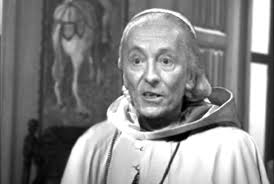
Movement is a struggle for all reconstructions because human movement is difficult to animate. Once again, “The Massacre” demonstrates small examples of movement than seem fluid, particularly in the first episode. “The Savages” on the other hand has main characters seemingly to perform scissor jump spread legged when the script call on them to walk.
How the animation occurs
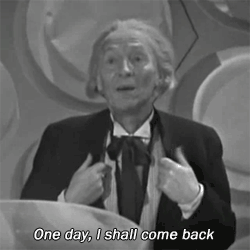
Having watched many of these animations, some of means AI generated these reconstructions became clearer. A lot of these animations, especially some of the later ones, do not actually generate much new material, instead using existing material in different ways. The First Doctor saying goodbye to Susan in the TARDIS, from Episode 6 of the Dalek Invasion of Earth, for instance is frequently re-used. This scene is redubbed multiple times in the reconstructions, when a missing story needs a scene of William Hartnell standing alone in the TARDIS.
Another method is using the telesnaps, and slightly animating the mouth and face. This creates a sense of fluidity and movement, but a very limited one. This is particularly noticeable in the Space Pirates. The resconstructions rely on switching between static photos of one cast member with mouths moving. On the one hand, this is no worse than the telesnaps, but the telesnaps were aware of their limitations, so often would use narration or subtitles to fill the gaps. However these reconstructions are presented as the most life like renditions of the missing episodes. As the original story did not have subtitles or narration, therefore, they are not allowed. As a result the story is incomprehensible.
Benefit – it exists
But despite the complaints, there is a significant benefit in these reconstructions. And that’s the fact that they exist.
Currently nine missing stories have not been officially animated by the BBC. I would love for all missing stories to be animated. However, the reality is most of the stories remaining might be too costly to animate.
Of the nine stories, six are pure historicals – stories with no science fiction elements apart from the TARDIS and its crew. These stories tended to have a larger number of human characters than stories with monsters, and a human being with their range of emotions is harder to animate than a Dalek.
Historicals also tend to have more detailed and complex scene change. A story in the future can replicate cold, grey corridors throughout a space colony. Historicals however must recreate significant locations in the world at particular times in history. Having to recreate 15th century France, for instance, is made up of multiple distinct locations. This makes historical stories more time consuming and therefore costly to animate. Therefore, despite stories being reanimated for almost twenty years now, the total number of historical episodes animated have been two – both missing episodes of the Reign of Terror.
For the remaining three stories, the limited human cast and isolated space station locations makes Wheel in Space relatively simple to animate. The Space Pirates, may also be animated as the story focusing mostly on space ships should make some aspects of the design easier to manage.
That just leaves The Dalek Masterplan¸ a massive twelve episode story, with a one episode prequel, where the Daleks chase the Doctor throughout time and space. The cast is huge, and while it is not a historical, the story would require animated sets of ancient Egypt during the building of the pyramids. None of this would be easy to do on the current BBC animation budget.
Therefore, it appears of the remaining nine missing stories, only two are highly likely to be animated.
And this is where AI can play a role. As AI does not rely much people, it means the costs to recreate a story like the Dalek Masterplan is significantly easier and cheaper than hiring a production studio to make it. While the end result is not as good as a professionally animated episode, for stories where hiring professional animations is not feasible, this is one way for people to observe a version of a story we otherwise cannot access.
Ultimately the frustrating thing about these reconstructions is they’re not allowed to be what they are. If they were simply an attempt to make otherwise lost stories more accessible, without any pretention or idea of superiority they would be fine. There are no shortages of fan made reconstructions, which vary in quality, but are all warmly received because they don’t pretend to be more than fan made animations. They are no better or worse than any other reconstructions.
If Levine’s reconstructions were presented with the same humbleness, the response would be more positive. If Leveine would present it as a project, and be accepting of others not needing to accpet them, there would be less retaliation online. But they aren’t presented as a fun way to view a loss episode. The reconstructions are presented as the only correct way to view the stories, superior than any other effort. In fact, he considers the stories no longer lost due to his AI reconstructions.
But by doing so, he puts the reconstructions on a pedestal of perfection. But they aren’t perfect, not by a long shot. By Leveine presenting these as perfect, he ultimately encourages people to notice how they are lacking by comparing to perfection. In comparison, more humble attempts of reconstruction, by presenting themselves as not the best, encourage people to notice what they do right.
So, try to enjoy the reconstructions for what they are. Some are surprisingly good – especially The Dalek Masterplan and The Massacre, and it’s a chance to see stories animated that you may not get to see animated elsewhere. But try to filter out all the rhetoric about how amazing and perfect they should be, and just enjoy them as they are.
 (2 / 5)
(2 / 5)
Related posts:
Movies n TV
Wheel of Time A Question of Crimson Is a Political Espionage Delight
Published
2 weeks agoon
March 17, 2025Episode two of Wheel of Time felt like the beginning of a long journey. Stories are unfolding, lives are changing, and blood is spilling.
Let’s discuss.
The story
We begin this episode in the past with Elayne’s mother, Queen Morgase. It turns out her rise to the throne was a bit, shall we say, cutthroat. So when she shows up at the White Tower, Siuan is concerned.
She might have reason to be, too.
Meanwhile, Rand, Egwene, Moiraine, Lan and Aviendha are in the Spine of The World. As they travel through some of the most breathtaking lands I have ever seen on a TV show, Egwene is plagued with nightmares. We think at first that’s just her trauma working itself through her system. But we soon find out that it might not be that straightforward.
Finally, Perrin returns home to heal after his hand is almost cut in half. But when he gets there he finds the town has been infested by Children of The Light. And they’re looking for him.
What worked
There was something heartwarming in this episode about political espionage and choking religious persecution. And that is Elayne’s relationship with her family.
I have consumed a lot of fantasy content with royal families. And I have never once heard a princess call her mother ‘Mum’. I’ve never seen royal siblings get along. And I have sure as hell never seen a princess have a good relationship with her step-parent.
This was refreshing. Even though Queen Morgase is kind of a horrible person she seems like a good mother. And that’s an unexpected delight.
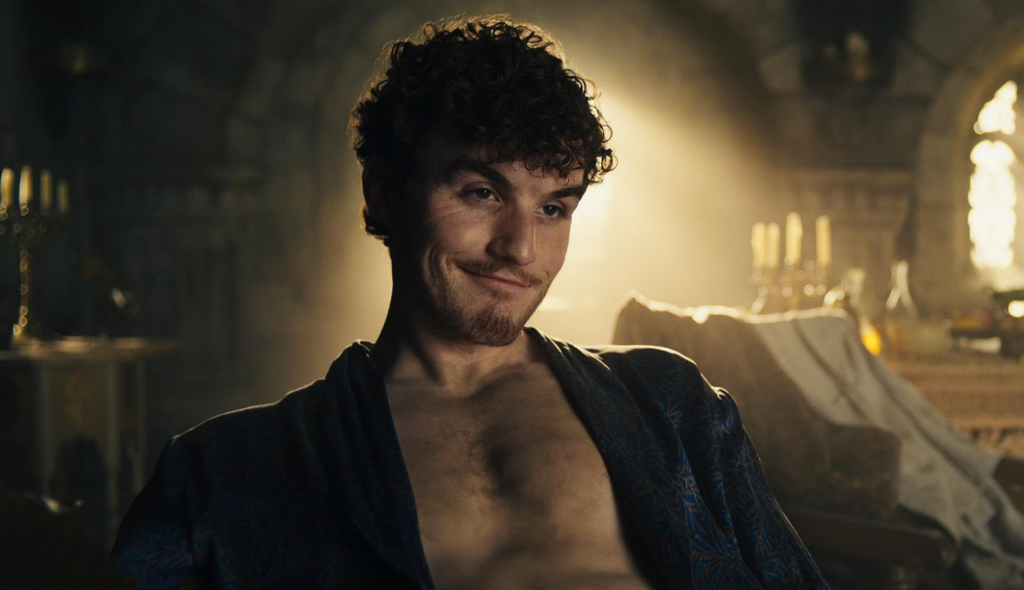
Of course, this is just one storyline among many. And while this can sometimes be overwhelming, in this case it wasn’t.
I’ll be honest, some of these storylines are going to drag for me. I know this because I’ve read some of the Wheel of Time books and I have an idea that not all the characters exactly pique my interest.
No one likes all the characters. No one likes all the storylines. While I am here for the political espionage between Queen Morgase and Siuan, not everyone likes it. While others might be fascinated with Selene trying to win Rand back, I couldn’t care less.
Having multiple storylines keeps everyone’s attention better. So long as things don’t get out of hand. Things can easily get out of hand. But this seems to be managed well.
So far.
What didn’t work
As I mentioned above, I’m not thrilled with Rand’s story at this point. And while it’s fine to not like a storyline when there are this many to choose from, it’s not fantastic that the one I like the least is the one involving our two main characters. And anytime we were with the team at the Spine of The World, the only thing that brought me joy was Moirain’s hat. It reminded me of Stockard Channing’s hat in Practical Magic.
The problem is that Rand is Charlie Brown with controversial magical powers. He is boring, serious, and pessimistic.
And yes, I understand that he has a heavy emotional burden and he’s the Dragon Reborn and that’s quite taxing and all. But let’s be fair, there isn’t a single person in this show that doesn’t have a heavy burden. And most of them manage to be fun occasionally.
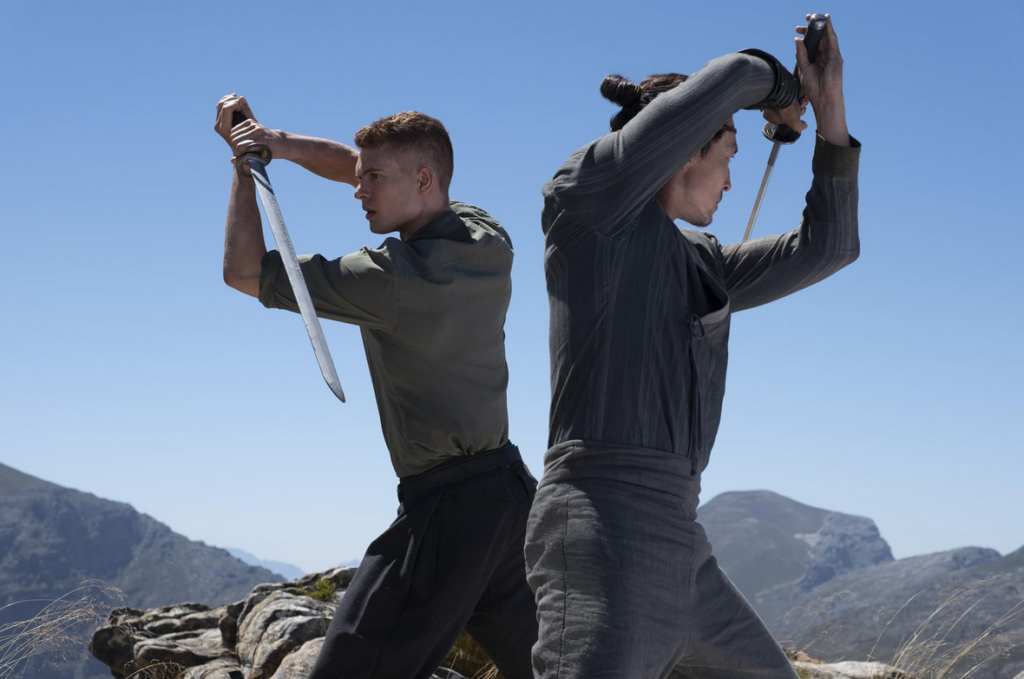
All that being said, this episode of Wheel of Time did exactly what it needed to do. It set up conflicts at each of the three locations. It established emotional ties between the characters and the events. And it established goals for everyone.
This was, in short, a solid episode. Not groundbreaking, not mind-blowing or life changing. It was simply good. It was entertaining and moved the plot forward.
Well done.
 (3.5 / 5)
(3.5 / 5)
Wheel of Time is back for season three. There are mixed feelings regarding this. Last season, there were some serious pacing issues. And some serious sticking to the book’s storyline issues. But we’re two seasons in, and we don’t give up so easily. So let’s dive into episode one, To Race the Shadow.
By the way, I highly recommend watching this episode with the subtitles on. You’ll see why.
The story
We begin this episode with Liandrin facing a trial of sorts for her rampant betrayal. She does her best to gaslight her Aes Sedai sisters into thinking that Siuan Sanche is the real traitor.
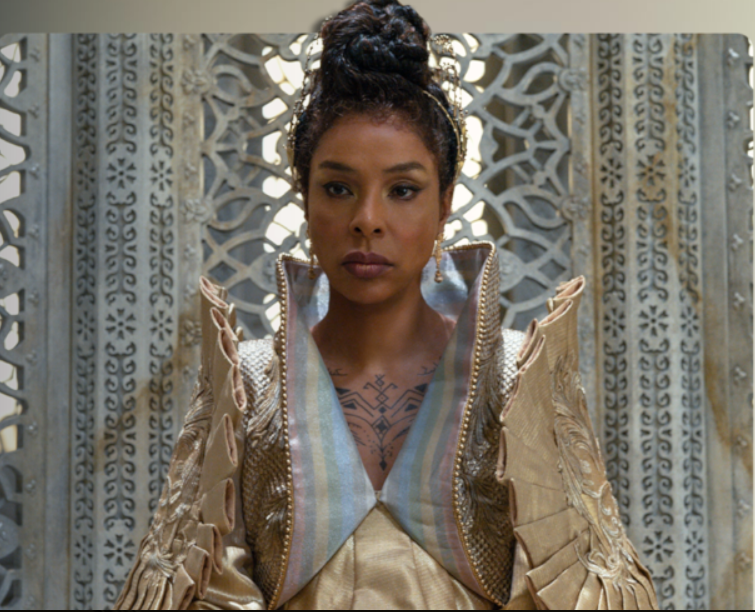
When that doesn’t work, she reveals how many Black Aes Sedai have actually infiltrated the tower.
Spoiler, it’s a lot.
In the aftermath, our whole team gathers to drink and enjoy one night of relaxation before they head out to the Tear to form an army for Rand. All is going well until they’re attacked by myriad creatures and a sentient axe.
What worked
This episode was long. It had a run time of an hour and eleven minutes. And a lot of that run time was spent in heavy dialog scenes.
Fortunately, these were well-done scenes.
If you’re going to have a lot of talking scenes, there are good ways and bad ways to do it. Last season, we saw lots of examples of the bad way to do it. But this episode did it well. For one thing, other things were going on while conversations were taking place. The characters are drinking, playing games, walking through an interesting city. And the scenes themselves didn’t stretch out. They weren’t repetitive. We heard what the character had to say, then we moved on.
It was also nice that the point of these scenes wasn’t just info dumps. We had character development. We had romantic interactions. We had plot development and foreshadowing.
Overall, this episode felt like what it was. A moment of calm before a storm.
Taking a step back, I’d be remiss if I didn’t address the fight scene at the start of the episode. Because it was epic.
The magic looked amazing. The martial arts that went along with it looked fantastic. The costumes were beautiful. It was just incredibly fun to watch.
More than that, it was emotional. We lost some characters in that fight that were important. And it was clearly emotionally shattering for many of our characters, who found themselves betrayed by people they trusted.
So many of them.
It was a great way to open the season.
What didn’t work
Despite that, this episode wasn’t without its flaws.
First off, there were a lot of dialog scenes. And they were good scenes, as I’ve already discussed. But it was one after another after another. And when your episode is, again, an hour and eleven minutes, it’s maybe a little much to have so much chit-chat. Couldn’t some of these conversations, important as they were, have been moved to maybe another episode?
Finally, I want to talk about Egwene’s travel through the arches.
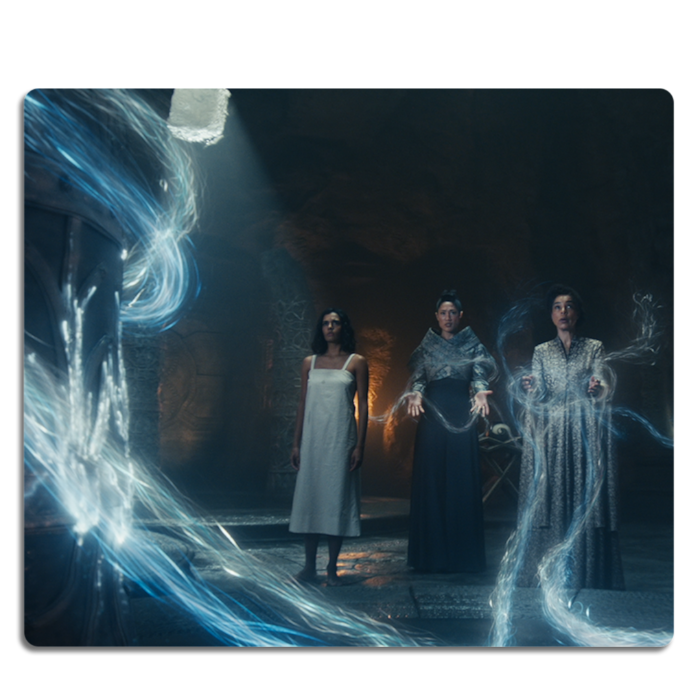
I feel like maybe there were some deleted scenes here. Because there must have been more to that visit than what we saw, right?
We could have seen Egwene battle Rand. That would have been badass and emotionally devastating. We could have seen her with a quiet life with Rand back home at the Two Rivers. We could have seen anything except for the quick clip of Rand in a bloody river, followed by Egwene being shoved back out in a bloody shift.
No products found.
Bad job. But at least it wasn’t an extended scene of Moiraine collecting bathwater, and then taking a bath while looking sad. If we’d started this season with another scene like that, it might have broken my brain.
Amazon dropped the first three episodes at once. So we’ll be back soon to talk about episode two. See you then.
 (4 / 5)
(4 / 5)

